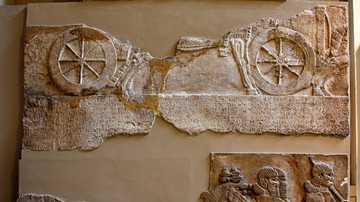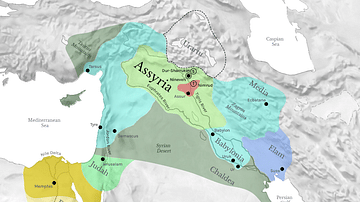Search
Did you mean: Tiglath Pileser I?
Search Results

Image
Assyrian Chariots
Assyrian wall panel, from the Central Palace at Nimrud (ancient Kalhu), Mesopotamia, modern-day Iraq, reused later in the South-West Palace, from the reign of Tiglath-Pileser III, c. 728 BCE. One of a series, it shows two disconnected scenes...

Video
A Short History of Assyria and the Neo-Assyrian Empire
Assyria has a long history, beginning in northern Mesopotamia and then expanding during the Neo-Assyrian Empire from Mesopotamia through Asia Minor, and down through Egypt. The empire began in the city of Ashur and went through many different...

Article
Mesopotamian Effects on Israel During the Iron Age
The Iron Age in the traditional Ancient Near Eastern chronology ranges from somewhere around 1200 BCE to 333 BCE. It begins from the era when it was first thought iron came to be used up to the ascendency of Alexander the Great as the major...

Image
Deported people from the city of Astartu
This detail depicts the deportation of the inhabitants of the city of Astartu (in modern-day Jordan Kingdom). The deported people are holding their personal belongings and are led by an Assyrian solider. The city was captured by the Assyrian...

Image Gallery
A Gallery of Assyrian Warfare
The Assyrian military was the most effective – and feared – fighting force in the Near East, especially during the time of the Neo-Assyrian Empire, 912-612 BCE, when their territory expanded across Mesopotamia, the Levant, into Asia Minor...

Image
Assyrian Battle Scene
Assyrian relief, from the Central Palace at Nimrud (ancient Kalhu), Mesopotamia, modern-day Iraq; reused later in the South-West Palace, from the reign of Tiglath-Pileser III, c. 728 BCE. An enemy horseman is ridden down by a pair of a armored...

Image
Neo-Assyrian Empire c. 912-612 BCE
Map of the Neo-Assyrian Empire c. 912-612 BCE, showing expansion by Shalmeneser III (r. c. 859-824 BCE), Tiglath-Pileser III (r. c. 745-727 BCE), Sargon II (r. c. 722-705 BCE), Sennacherib (r. c. 705-681 BCE), and Ashurbanipal (r. c. 688-627...

Image
Statue of Yerah' Azar
The inscriptions of this limestone statue mention that the statue belongs to Yerah'Azar, son of Zakir, son of Sanipu. Sanipu is known to have submitted to the Assyrian king Tiglath-Pileser III in the year 733 BCE. The eyes were originally...

Image
Assyrian Warriors Relief
Basalt reliefs depicting Assyrian warriors of different ranks in procession with a royal chariot led by the commander-in-chief of the Assyrian army. The reliefs were acquired and gathered during the years 1848, 1946, 1948, 1982, and 1995...

Image
Assyrian Deportation of People
Assyrian relief, from the Central Palace at Nimrud (ancient Kalhu), Mesopotamia, Iraq. This is one of a series of panels that showed Tiglath-Pileser III's military campaigns in modern-day southern Iraq. On the left is a captured town, with...